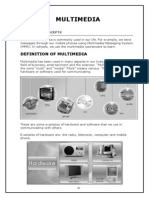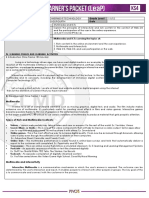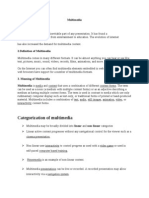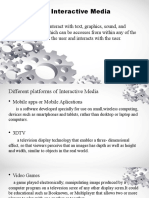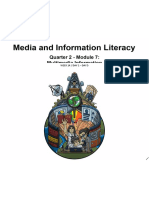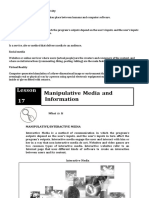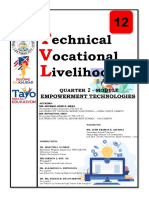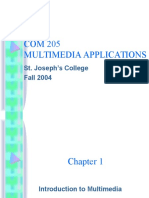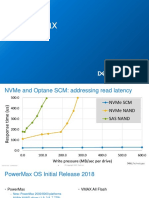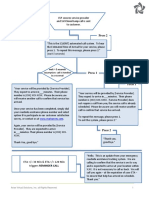Interactive
Multimedia
Introduction
Lecture 1
� Outline
Definitions
History
Advantages
Example
Applications
2
�What is
multimedia?
• Is a form of communication that relies
on the use of combined content forms
such as text, audio, images,
animations, video and interactive
content.
• Unlike “traditional” mass media
(printed media, recorded audio/video)
it includes rich contents to different
context and output and channels.
• It is typically delivered to the audience
by electronic or digitally manipulated
means (real/on-demand steaming,
podcast, animation, showreel, etc.).
3
�What is Interactive
Multimedia?
• Instead of one way communication,
interactive multimedia takes input from
users and delivers an appropriate output.
Hence creating more engagement with the
media and affinity to the topic.
• Interactive media works with the user's
participation. The media still has the same
purpose but the user's input adds
interaction and brings interesting features
to the system for better experience, of
course subject to how much do we know
about our users and the way they think
and behave..
4
�Linear Vs Non Linear
Multimedia
• Projects that are not interactive are called
linear.
• E.g. A book might be defined as a multimedia
format in that it can include pictures, maps,
graphs, charts, or timelines, but while it uses
other media, it is not interactive.
• A reader can use the index at the back of a book,
or flip through pages, but the text itself has only
one hierarchy of topics and is intended to be read
from beginning to end.
• Projects where users are given navigational
control are called nonlinear and user-
interactive.
• E.g. blockbuster video games can be described as
much more highly interactive multimedia
5
�Related Concepts
• Digital Experience
Is the interaction between a user (Customer,
partner or employee) and an organization that is
made possible through digital technologies.
• Emerging/New Media
Refers to multimedia contents available online
live/on-demand but using new channels/formats
for its delivery newspapers, video games, wiki,
interactive objects, etc…
Think of interact
ive cubes!
6
� Related
Concepts
• Human Computer Interaction
A domain that is concerned with the
design and use of computer technology,
focused on the interaction tools, methods,
and paradigms between people (users)
and and machines (computers).
• Augmented Reality
Is a live direct or indirect view of a
physical, real-world environment whose
elements are augmented (or
supplemented) by computer-generated
sensory input such as sound, video,
graphics, internal orientation (gyroscopic),
or external orientation (GPS) data as a
way of controlling or triggering
input/output integrated between the world
viewed on screen and overlayed on the
real scene.
7
� Why Interactive
Multimedia?
• Effects on Learning
Using interactive machines/systems with the
educational domain to facilitate learning helps
students develop better communication and
articulation skills producing a positive attitudes and
further engagement in the process particularly if
multisensory is deployed.
• Retention of Information
Media Retentio
Type n Rate
Audio 20%
Audio 30%
Visual
Interactive 60%
Multimedi
a
8
�Why Interactive Multimedia
• Intuitive Understanding
Interactive products such as smartphones, and websites
are all easy to use. This is a deliberate outcome that
aims to encourage the use of these products allowing
consumers to experiment with their products rather than
reading instruction manuals.
Think of new gadgets, phone, tablets, digital pens, smart
devices, etc.
However, a lot of research and thinking goes behind the
scene
to allow users to perceive this easy concept. From social,
cognitive, psychological, technological, and behavioural
aspects.
9
�Digital
Interactivity
Then and Now
• Elements that encouraged the
development of Interactive
Multimedia
Laser Disc Technologies
The graphical user interface GUI
Sharp fall in hardware costs and
increased computer speed and
capacity
Integrated Circuits developed as
processors, audio, video and storage
components (SSD desk?)
Take a look at Computing system Time-
Line
10
�• The Introduction of the WWW
With the commercialization of the
internet, digital content began moving
from individual computers to being
shared worldwide.
The Web is based on hypertext, a system
of embedding links in text to connect to
other, related, text.
The language for the development of
hypertext is called the hypertext mark-up
language, or HTML.
Back to 1990s?
Digital Interactivity Then
and Now
11
�Keeping Up with • Newer systems engage the user with all the
senses
the Interactive Touch screens with gesture recognition
Voice activation
Media Immersive 3D animated graphics
Motion capturing
Consumer Not too far beyond– digital scent???
12
�Screen Gestures
13
�Examples
• Information outlets (YouTube)
Public places - Multimedia is available at stand-alone
terminals or kiosks to provide information and help.
14
�Examples
• Shopping Apps
• Airlines Self Check In
16
�Interactive • https://thecoolclub.co/
Websites
17
�Education
• Schools - Educational software can be developed to
enrich the learning process.
• Interactive TV is widely used among campuses to
join students from different locations into one class
with one teacher
18
�Video Games
• Is an electronic game that involves interaction with
a user interface to generate visual feedback on a
video device such as a TV screen or computer
monitor.
19
�Virtual Reality
– Virtual reality is an extension of multimedia.
– It uses the basic multimedia elements of imagery,
sound, and animation.
– It requires terrific computing horsepower
to be realistic.
Extended Reality ?
20










